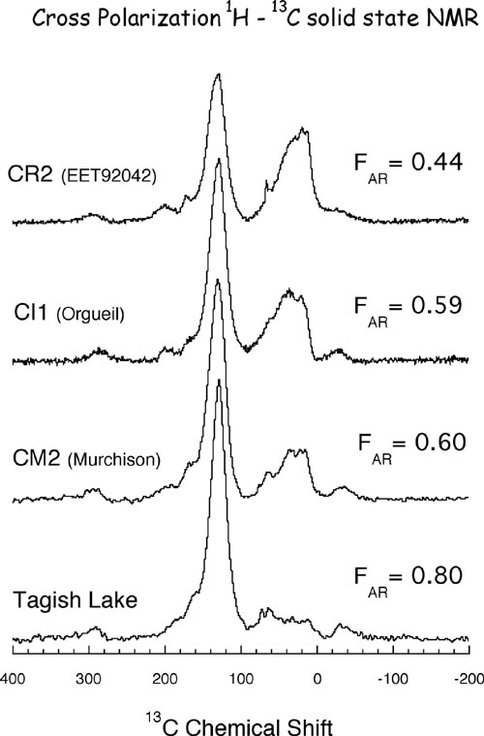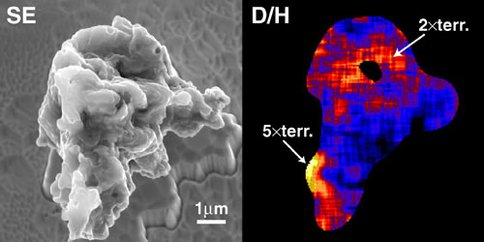2003 Annual Science Report
 Carnegie Institution of Washington
Reporting | JUL 2002 – JUN 2003
Carnegie Institution of Washington
Reporting | JUL 2002 – JUN 2003
Studies of Organic Matter and Water in Meteorites
Project Summary
The mechanisms that produced chondrules and CAIs were important, energetic processes in the early Solar System that would also have led to complex gas-phase chemistry.
Project Progress
Task 1. Chondrule Formation and Solar Nebula Chemistry (Desch)
The mechanisms that produced chondrules and CAIs were important, energetic processes in the early Solar System that would also have led to complex gas-phase chemistry. This chemistry may have influenced the composition of organic matter in meteorites and may produce telltale signatures that would be observable in developing planetary systems.
In the past year, postdoctoral fellow Steven Desch and collaborators have made progress in determining some of the chemical effects of chondrule-melting shock waves on the gas in the solar nebula. They used their previously published chondrule formation model to constrain the pressures and shock speeds in the chondrule formation region. For likely shock speeds of 7 km/s, they demonstrated that ammonia is readily dissociated. Slightly stronger shocks can also dissociate molecular nitrogen. The liberated nitrogen was shown to be incorporated into radicals such as NO and into nitriles. These results have inspired an observational effort underway now at Department of Terrestrial Magnetism (DTM) to observe NO in protoplanetary disks. The nitriles are likely to participate in the organic chemistry that results in the macromolecular material found in meteorites.
Task 2. Chemical Structure of Meteoritic Macromolecule (Alexander, Cody, Tera)
The organic matter in primitive chondritic meteorites has attracted considerable attention, not only because it retains a record of synthesis in the interstellar medium and possibly the solar nebula, but also because it may have been an important component of the prebiotic organic matter on the early Earth and other Solar System bodies.
Alexander, Cody, and Tera continued their studies of extraterrestrial organic matter contained within carbonaceous chondrites. They prepared high-purity residues from a suite of meteorites that experienced a range of parent body conditions. These include the CMs Cold Bokkveld, ALH 83001, and Y86720; the CRs EET 92042 and GRA 95229; and the COs ALH77307 and ALH 83108. Solid-state (1H and 13C) Nuclear Magnetic Resonance (NMR) has revealed considerable diversity in the compositions of the organic matter in these meteorites (Figure 1). The NMR results are supported by Gas Chromatography Mass Spectroscopy, as well as by isotopic and elemental analysis. The results suggest that if, as seems likely, there was a common source of organic matter in chondrites, this primordial material would have most closely resembled the organic matter found in CR chondrites. Aqueous alteration and/or thermal metamorphism under a variety of conditions on the different chondrite parent bodies produced the range of compositions now observed.
Cody recently collaborated with Monica Kress and Donald Brownlee (University of Washington) to assess the extent to which micrometeorites would have provided organic molecules to Earth’s early atmosphere. Their approach was to flash-heat (500 K/s) fine-grained samples of Murchison (a CM2 carbonaceous chondrite) up to ~ 1000 K. The organic matter thermally evolved during flash heating is chemically complex, including numerous single- and double-ring aromatic compounds (variously functionalized with oxygen- and sulfur-containing functional groups). A large influx of such extraterrestrial matter would have had profound influence on the early Earth’s atmosphere by providing both partial ultraviolet (UV) shielding and potentially interesting photochemistry.
Task 3. Interplanetary Dust Particles (Nittler, Mukhopadhyay)
Interplanetary dust particles (IDPs), collected in the stratosphere, are believed to have been an important contributor of organics to the early Earth. IDPs are known to contain large and variable isotopic enrichments of deuterium and 15N, believed largely to reflect incomplete processing of presolar organic material from the Sun’s parental molecular cloud.
Larry Nittler and Sujoy Mukhopadhyay are using ion probe techniques to constrain the characteristics and origins of organic matter in IDPs. Isotopic imaging of H, C, and N isotopes in fragments of seven IDPs with ~1 micron spatial resolution has revealed a number of distinct components with different H and N isotopic compositions (Figure 2). Both H and N are isotopically heterogeneous on a micron scale. Although the highest D/H and 15N/14N ratios are always associated with carbonaceous material, there is little correlation between the two isotope systems. In fact, the highest 15N/14N ratios are associated with material with relatively modest D enrichments. Moreover, ion imaging has revealed for the first time clear evidence for a D-rich, but C-poor, component in IDPs. This material most likely consists of hydrated minerals such as phyllosilicates and has a D/H ratio remarkably similar to that observed in cometary water. Transmission electron microscopy and synchrotron analyses are planned to determine the precise chemical makeup of the isotopically analyzed IDPs. Mukhopadhyay and Nittler have also recently performed the first sulfur isotopic measurements of IDPs. No large isotopic variations indicating preservation of presolar material have been identified.
Task 4. Hydrogen Isotope Signature of Minerals and Melt Inclusions in Martian Meteorites (Alexander, Boctor, Hauri, Wang)
The H isotopic composition of water in Martian meteorites has the potential for providing information about the origin and evolution of water on Mars.
Boctor and colleagues completed and published an initial survey of 7 Martian meteorites whose ages span much of Martian history (180-4,000 Myr). In all of them even nominally anhydrous minerals often contained deuterium-rich water, indicative of exchange with the Martian atmosphere. There is a factor of two increase in the maximum measured D-enrichments from the oldest to the youngest meteorites. However, at present it is not clear whether this indicates a progressive change in the Martian atmospheric composition over time or is due to some combination of shock processing and/or variable terrestrial contamination.
Task 5. Iron Isotope Measurements of Terrestrial Rocks and Meteorites (Hauri, Emerson, Kehm)
The possibility that metabolic processing of Fe can produce measurable isotopic fractionation has stimulated wide-ranging efforts to measure such effects in various terrestrial settings. Kehm and Hauri recently developed a technique for measuring precisely the relative abundances of 54Fe, 56Fe, and 58Fe in natural samples. The technique uses an Inductively Coupled Plasma (ICP) mass spectrometer operated at reduced plasma temperatures to produce a stable ion beam with minimal isobaric interferences from molecular species indigenous to the Ar plasma gas.Results of this initial project include the demonstration of homogenous Fe isotope compositions among both differentiated and undifferentiated bulk meteorites and terrestrial Hawaiian basalt samples. However, variations ranging up to δ56Fe = -0.5‰ relative to terrestrial basalt Fe were observed in meteoritic chondrules from an ordinary chondrite. Such variations can plausibly result from rapid Fe condensation in the solar nebula and thus may ultimately provide important constraints on chondrule formation and alteration models.
Since this work, Kehm, Hauri, and Emerson have undertaken a related project to determine the extent of possible isotopic mass fractionation of Fe associated with Fe-metabolizing bacterial colonies around hydrothermal vents on the Loihi seamount. These measurements have indeed revealed isotopically heavy Fe (δ56Fe ranging up to +0.5‰) in a number of Fe-rich sediments. Currently the group is extending these measurements to a new suite of Loihi bio-precipitates in order to verify and definitively quantify the range of the effects. Their ongoing studies of Fe mass fractionation in chondrules include analyses of chondrules from meteorites from different parent bodies in an effort to determine whether the observed isotopic mass fractionations are parent body or nebular in origin.
-
PROJECT INVESTIGATORS:
-
PROJECT MEMBERS:
Nabil Boctor
Collaborator
Karl Kehm
Collaborator
Fouad Tera
Collaborator
Jianhua Wang
Collaborator
Steven Desch
Postdoc
Sujoy Mukhopadhyay
Postdoc
Michael Smoliar
Postdoctoral Fellow
-
RELATED OBJECTIVES:
Objective 1.1
Models of formation and evolution of habitable planets
Objective 2.1
Mars exploration
Objective 3.1
Sources of prebiotic materials and catalysts
Objective 3.2
Origins and evolution of functional biomolecules






